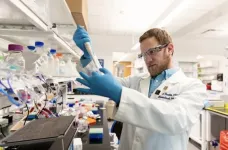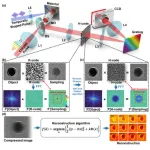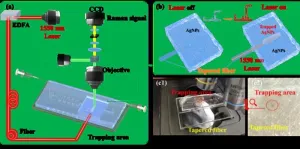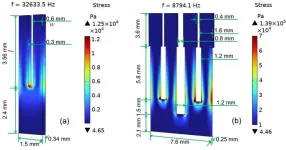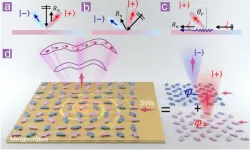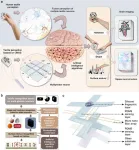(Press-News.org) As many as 40% of Americans are obese, putting them at an increased risk for high blood pressure, diabetes, stroke, heart disease and certain cancers, according to the CDC. New research from the University of Delaware aims to tackle the issue by investigating obesity at the gene level.
Principal investigator Ibra Fancher, assistant professor of kinesiology and applied physiology in UD’s College of Health Sciences, discovered significant differences in gene expression in adipose tissue, more commonly known as fat. Formerly considered fat storage, adipose tissue is now recognized as a vital endocrine organ. Dysfunction in the tissue is linked to significant cardiovascular and metabolic diseases.
In the study published in Physiological Genomics, Fancher and colleagues examined how diet impacts gene expression in adipose tissue using an animal model. One group consumed a diet akin to a typical high-fat, high-caloric Western diet, while the other ate a standard chow for over a year.
“We expected to see robust changes in fat, and indeed, the adipose depots in the high-fat group were much different, showing significant changes related to poor diet and obesity,” Fancher said.
Key findings
The study, funded by a federal National Institutes of Health grant to UD’s Center of Biomedical Research Excellence (COBRE) in Cardiovascular Health, found more than 300 genes were differentially expressed in subcutaneous adipose tissue (SAT), a less dangerous form of fat. In comparison, nearly 700 genes were differentially expressed in visceral adipose tissue (VAT). Visceral fat, or fat around vital organs, raises a person’s risk for significant health issues.
“The comparison of VAT to SAT is stark. The expansion of visceral fat, along with its inflammatory role in obesity and metabolic diseases, is particularly severe,” Fancher said. “This study highlights the impact of obesity, which often results from a poor diet and sedentary lifestyle, on specific adipose tissues, which is very likely a major factor affecting health. That makes the affected tissue a good target for interventions to protect other systems.”
Among the thousands of genes analyzed, Fancher’s research identified four genes related to metabolism, calcium handling and inflammation that warrant further investigation.
“We’re already looking to see if these genes are worthwhile pursuits in improving adipose tissue function in obesity,” Fancher said. “They could potentially be targeted with existing drugs or spawn new treatments specifically designed to influence these genes.”
An innovative approach
Fancher worked with Bruce Kingham, director of UD’s Sequencing and Genotyping Center at the Delaware Biotechnology Institute, and Shawn Polson, director of the Bioinformatics Data Science Core at UD’s Center for Bioinformatics and Computational Biology and Delaware INBRE, as well as a research professor in the Department of Computer and Information Sciences in the College of Engineering.
“Our core facilities provide access to the advanced technologies and expertise for RNA sequencing and bioinformatics that enable UD investigators to do this type of research,” Polson said. “In this project, when we analyzed the data, it very clearly pointed us to obesity-related genes and pathways that varied between VAT and SAT.”
From left to right, Shawn Polson, director of the Bioinformatics Data Science Core at UD’s Center for Bioinformatics and Computational Biology and Delaware INBRE, and research professor in the College of Engineering’s Department of Computer and Information Sciences; Ibra Fancher, assistant professor of kinesiology and applied physiology; Mark Shaw, research associate in UD’s Sequencing and Genotyping Center at the Delaware Biotechnology Institute, collaborated on this research.
Malak Alradi, a third-year doctoral student studying molecular biology and genetics, played a key role in organizing the genes into pathways to better understand their biological significance.
“Before I started this research, I thought fat was the same in the body, but when I saw the RNA sequencing and studied the different genes and pathways, I realized that VAT is affected by obesity far more than SAT,” Alradi said. “Our approach shows how interconnected these processes are and why targeting specific pathways could make a difference in obesity treatment.”
Stringent statistical methods also confirmed key findings about adipose depots, including changes in metabolism and inflammation.
“That makes us feel really good about the genes we identified,” Fancher said. “It underscores the novelty of our findings.”
Next steps
Fancher now plans to study gene expression in human adipose tissue. In collaboration with Dr. Caitlin Halbert, director of bariatric surgery at ChristianaCare, Fancher aims to determine whether previous findings apply to human samples.
He also noted the potential for sex differences.
“Obesity influences the sexes very differently, so I would not be surprised if we found sex differences,” Fancher said. “Recognizing these differences is crucial to tailoring more personalized and targeted interventions.”
END
Decoding fat tissue
UD researchers find gene expression differences in fat may hold the key to targeted obesity treatment
2025-02-08
ELSE PRESS RELEASES FROM THIS DATE:
Solar and electric-powered homes feel the effects of blackouts differently, according to new research from Stevens
2025-02-08
Hoboken, N.J., February 7, 2025 — As winter storms and summer heat waves increasingly stress the nation’s power grids, Stevens researchers have developed a new way to identify the homes most vulnerable to blackouts — without even visiting them.
The timing couldn't be more critical. With more than a quarter of U.S. homes already fully electric, and solar installations set to triple during the next five years, understanding vulnerabilities has become critical for emergency planning and public safety.
"We're ...
Metal ion implantation and laser direct writing dance together: constructing never-fading physical colors on lithium niobate crystals
2025-02-07
A new publication from Opto-Electronic Advances; DOI 10.29026/oea.2025.240193 , discusses a novel approach towards robust construction of physical colors on lithium niobate crystal.
Color has a profound impact on the way humans observe, perceive and understand the world. It is like a silent language, subtly shaping our perception and response to the surrounding environment. From the first ray of sunshine in the morning to the twinkling stars in the night sky, colors are everywhere. They are not only a visual ...
High-frequency enhanced ultrafast compressed photography technology (H-CAP) allows microscopic ultrafast movie to appear at a glance
2025-02-07
A new publication from Opto-Electronic Advances; DOI 10.29026/oea.2025.240180 , discusses high-frequency enhanced ultrafast compressed photography technology.
Single-shot ultrafast imaging technology can characterize transient events under a wide range of conditions. It opens the door to explore the unrepeatable or difficult to reproduce ultrafast phenomena such as photosynthesis at the molecular or atomic scale in nature and the precision manufacturing of semiconductor ...
Single-beam optical trap-based surface-enhanced raman scattering optofluidic molecular fingerprint spectroscopy detection system
2025-02-07
A new publication from Opto-Electronic Advances; DOI 10.29026/oea.2025.240182 , discusses a single-beam optical trap-based surface-enhanced Raman scattering optofluidic molecular fingerprint spectroscopy detection system.
Raman spectroscopy is a non-destructive analytical technique that allows for precise analysis of substances based on their unique molecular Raman spectral characteristics. However, traditional Raman spectroscopy techniques suffer from weak signal intensity, limiting their sensitivity in high-sensitivity detection applications. Surface-enhanced Raman scattering (SERS) technology, on the other hand, can amplify Raman signals by several million ...
Removing large brain artery clot, chased with clot-buster shot may improve stroke outcomes
2025-02-07
Research Highlights:
Stroke survivors were more likely to have little or no disability after 90 days if a clot was removed from a large brain artery followed by the injection of the clot-dissolving medication tenecteplase directly into the artery near the blockage, compared to people receiving standard medical treatment after clot removal. In this trial, standard care was clot removal without clot-dissolving medication.
The added treatment may work by dissolving blood clots in the small vessels (microcirculation) near the major blockage, reducing the amount of brain tissue deprived of blood.
The ANGEL-TNK trial found that this approach was ...
A highly sensitive laser gas sensor based on a four-prong quartz tuning fork
2025-02-07
A new publication from Opto-Electronic Advances; DOI 10.29026/oea.2025.240275, discusses A highly sensitive laser gas sensor based on a four-prong quartz tuning fork.
Trace gases, though have a volume fraction much less than 1% of the atmosphere, significantly impact various sectors. Despite their low concentration, typically between 10-12 to 10-6, gases like nitrogen oxides (NOx), sulfur dioxide (SO2), and greenhouse gases contribute to atmospheric pollution, a pressing global issue exacerbated by industrialization and urbanization. Moreover, detecting trace gases is crucial for industrial ...
Generation of Terahertz complex vector light fields on a metasurface driven by surface waves
2025-02-07
A new publication from Opto-Electronic Sciences; DOI 10.29026/oes.2025.240024, discusses generation of terahertz complex vector light fields on a metasurface driven by surface waves.
With the rapid development of information and communication technologies, especially in the context of 5G, 6G networks, artificial intelligence, and the Internet of Things, the development of on-chip optical control devices with high bandwidth, high speed, low power consumption, and miniaturization ...
Clot-busting meds may be effective up to 24 hours after initial stroke symptoms
2025-02-07
Research Highlights:
In a randomized clinical trial in China, giving the clot-busting medication alteplase up to 24 hours after stroke symptoms first appeared increased the odds of better recovery by 50% compared to those who received standard antiplatelet treatment.
The results might extend the time window for patient treatment worldwide, particularly in regions that lack access to advanced medical procedures.
Note: The study featured in this news release is a research abstract. Abstracts presented at the American Heart ...
Texas Tech Lab plays key role in potential new pathway to fight viruses
2025-02-07
Five years removed from the COVID-19 outbreak, scientists around the world are still studying its effects and, more importantly, ways those effects can be mitigated in the future. An international team of researchers may have just found a critical clue in the quest, and a laboratory at Texas Tech University played a key role.
The Ray Laboratory, led by Department of Biological Sciences Professor and Associate Chair David Ray, as part of a study on bat genomes published by the scientific journal Nature, helped identify the components of a genome in a specific species of bats that have shown more genetic adaptations in their immune systems than other animals.
The study revealed that a gene ...
Multi-photon bionic skin realizes high-precision haptic visualization for reconstructive perception
2025-02-07
A new publication from Opto-Electronic Advances; DOI 10.29026/oea.2025.240152, discusses how multi-photon bionic skin realizes high-precision haptic visualization for reconstructive perception.
Human palm skin contains more than 20,000 tactile vesicles, depending on the tactile vesicles in the skin depth, activation threshold, trigger mode and other tactile signal pickup differences, as well as cross-synergistic mechanism between them, so that the skin can obtain different types of tactile signals. And then through the brain nerve center on the tactile signal “calculation” ...
LAST 30 PRESS RELEASES:
Practical education: Clinical scenario-based program development
The impact of family dynamics on eating behaviour – how going home for Christmas can change how you eat
Tracing the quick synthesis of an industrially important catalyst
New software sheds light on cancer’s hidden genetic networks
UT Health San Antonio awarded $3 million in CPRIT grants to bolster cancer research and prevention efforts in South Texas
Third symposium spotlights global challenge of new contaminants in China’s fight against pollution
From straw to soil harmony: International team reveals how biochar supercharges carbon-smart farming
Myeloma: How AI is redrawing the map of cancer care
Manhattan E. Charurat, Ph.D., MHS invested as the Homer and Martha Gudelsky Distinguished Professor in Medicine at the University of Maryland School of Medicine
Insilico Medicine’s Pharma.AI Q4 Winter Launch Recap: Revolutionizing drug discovery with cutting-edge AI innovations, accelerating the path to pharmaceutical superintelligence
Nanoplastics have diet-dependent impacts on digestive system health
Brain neuron death occurs throughout life and increases with age, a natural human protein drug may halt neuron death in Alzheimer’s disease
SPIE and CLP announce the recipients of the 2025 Advanced Photonics Young Innovator Award
Lessons from the Caldor Fire’s Christmas Valley ‘Miracle’
Ant societies rose by trading individual protection for collective power
Research reveals how ancient viral DNA shapes early embryonic development
A molecular gatekeeper that controls protein synthesis
New ‘cloaking device’ concept to shield sensitive tech from magnetic fields
Researchers show impact of mountain building and climate change on alpine biodiversity
Study models the transition from Neanderthals to modern humans in Europe
University of Phoenix College of Doctoral Studies releases white paper on AI-driven skilling to reduce burnout and restore worker autonomy
AIs fail at the game of visual “telephone”
The levers for a sustainable food system
Potential changes in US homelessness by ending federal support for housing first programs
Vulnerability of large language models to prompt injection when providing medical advice
Researchers develop new system for high-energy-density, long-life, multi-electron transfer bromine-based flow batteries
Ending federal support for housing first programs could increase U.S. homelessness by 5% in one year, new JAMA study finds
New research uncovers molecular ‘safety switch’ shielding cancers from immune attack
Bacteria resisting viral infection can still sink carbon to ocean floor
Younger biological age may increase depression risk in older women during COVID-19
[Press-News.org] Decoding fat tissueUD researchers find gene expression differences in fat may hold the key to targeted obesity treatment
